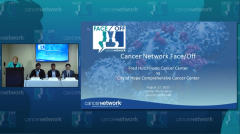
Cross Q&A: Navigating Biochemical Relapse and MRD Resurgence in Multiple Myeloma
An insightful discussion among specialists about the challenges of treating biochemical relapse and MRD resurgence in multiple myeloma patients, exploring nuanced considerations, patient collaboration, and the evolving landscape of treatment strategies.
Episodes in this series

Transcript:
Judy Schreiber, PhD, RN: Thank you very much, Dr Cowan. City of Hope, any comments or questions you want to give back to our Fred Hutch[inson Cancer Center] team?
Murali Janakiram, MD, MS: Hi, this is Murali here. Great talk, Dr Cowan. Very good. You’re right amongst the questions. I think one of the biggest challenges in dealing with biochemical relapse or treating a biochemical relapse is a lead time bias. Which definitely, as you said, makes the [progression-free survival] go better, but one can argue that when we are looking at overall survival, the lead time bias is gone. But it also depends on the next line of therapies and what the patients keep receiving. The next one is maybe, as you said, people whom we are detecting through biochemical relapse are being followed more closely and we are able to detect it. These are some of the issues, as you know, in the real world, which we face. I don’t know whether a free light chain [test result] of 5 mg/dl is any worse than 11 mg/dl. How do you, in your clinical practice, reconcile all [of this]?
Andrew J. Cowan, MD: Thanks, [Dr Janakiram]. That’s an excellent question. I agree with all the points you made, especially about lead time bias. But also, again, I would highlight the disease biology issue too. Because I think really some of these patients, they just have MGUS [monoclonal gammopathy of undetermined significance] again. They don’t have myeloma. We’ve eliminated whatever clones were bad. But to your question about when to initiate treatment, that’s a common, long topic of discussion. I will say that for patients with a progressing free light chain, I tend to lean pretty heavily on the data from England. I think it was one of the MRC trials, maybe MRC 10. They showed that at a cutoff of 800 mg/liter, once you get above that, there’s a substantial risk of renal failure.
I’ve tended to use that as an absolute threshold for starting treatment. If someone really doesn’t want to start treatment, I’ll say, well, we probably want to start before the light chains get above 80 mg/dl. Because then we start getting worried about renal failure, especially if they have a lot of Bence-Jones protein. But certainly…if the light chains are getting close to that level, I would have wanted to start treatment earlier. But it also depends on the kinetics too. An M-spike of 0.5 is less concerning to me if someone maintains that for…2 years and I’m watching them closely and we’re getting regular imaging.
And how often we get imaging and bone marrow [biopsies] is…something else we don’t really have clear data on either. Is there an absolute threshold for when? I have tended to start once the monoclonal protein gets above 1. But I’m open to admitting that that’s not backed by data.… That’s the threshold often for measurable disease in clinical trials. It’s become a habit. But I concede that there [are] not data that one must initiate an M-spike of 1 or 1.5 or whatever. That’s how I practice. I’m always open with this…when I discuss with patients. It is also a conversation with patients too. Some people feel really nervous about just sitting on it. [In] that patient, I might be more likely to start treatment earlier.
Rahul Banerjee, MD, FACP: And I’ll just add to that completely, Dr Cowan—nice to see you—and Dr Janakiram. I think if we go past biochemical, past the 0.5 threshold and we continue to monitor, Dr Cowan’s last point I completely agree with. I discuss with the patient, try to have a line in the sand that we set; 0.5 is arbitrary, but patient by patient, I try to say, look, I don’t know when it’ll happen. But when it hits…1.0, that should be a time to do something. Just because otherwise, it’s like the frog in the rising-water-temperature analogy from 20 years ago in that climate change movie. It’s very easy for inertia to say, “Oh, well, now it’s 1.1, now it’s 1.2. But let’s not change anything now.” I think that causes more anxiety for the patient. I agree; 0.5 is largely arbitrary, 100 mg/l. I trained in a milligram-per-liter institution. It’s also largely arbitrary. But I think setting a goal with the patient and saying, “Look, here’s what we decided on years ago. Now we’ve crossed that threshold,” I think is often helpful.
Murali Janakiram, MD, MS: Let me ask you both a more provocative question. Would you be more afraid…of a myeloma, which is having a biochemical relapse vs an increasing MRD [minimal residual disease], and you have zero MRD and now it’s slowly increasing over time, over 3 months, 6 months, doubling. Do you have a preference on which one is a more robust one?
Andrew J. Cowan, MD: That’s a great question. It comes up a lot. Now that we have MRD testing, it’s a data point that people get anxious about. I think you just have to look at it in terms of tumor burden. Even though there’s a lot of variance in terms of how much MRD reflects the total tumor mass, I think if one considers that, to some degree, end organ damage is probably influenced by total tumor volume and how much disease there is, I do treat MRD resurgence differently.
I typically would not change treatment based on MRD resurgence, but I know that there are those who would.… This is certainly an area where even more than biochemical relapse, we don’t have good data. But I know there [are] myeloma specialists who do recommend changing treatment based on a change in MRD status, but I am not one of them. I have typically opted to monitor closely with the knowledge that compared with a patient who has a light chain that’s increasing above 20 mg/dl, an MRD going from 10 to 20, we’re talking about a much smaller absolute tumor volume. I feel much more comfortable monitoring that patient who is having a biochemical resurgence. But Dr Banerjee, I’m interested in how you would practice.
Rahul Banerjee, MD, FACP: Then I’ll put the same question back to you, Dr Janakiram, as well. But so, I would say that Dr [Vijayalakshmi] Mohan and colleagues from [the University of Arkansas for Medical Sciences, in Little Rock] presented their data, published it a couple years ago, and 27% of patients with MRD resurgence never have a clinical relapse or biochemical [relapse]. You’re right, we just don’t know enough. Dr Cowan alluded to the idea of this MGUS-like phenotype. Some of these patients with biochemical relapse or MRD resurgence probably are the MGUS-like phenotype. I’m sure in 30 years we’ll know how to tell properly. We’re scratching at that surface now, but in the absence of that, I don’t think it’s fair to escalate that dramatically for MRD resurgence. How does that match…Dr Liu…your practice as well?
Lawrence W. Liu, MD: I think a lot of that also potentially depends on the patient’s level of comfort with where their objective data [are] at, and also definitely any signs of symptoms, I think, would warrant concern for treatment.
Murali Janakiram, MD, MS: I think that’s a great point, [Dr Banerjee] and [Dr Cowan], regarding the question of MRD resurgence and when to treat it. Similarly, biochemical relapse, I think the percentages start looking the same, where people maintain a biochemical relapse for quite some time without any hints of progression once it starts reaching a certain level.… At this point of time, unless there is a clear high-risk biology, a functional high risk, I don’t treat MRD resurgence, and I reassure most of my patients to do follow-up. But I agree, I think we need a much better understanding of the biology of the disease before we can treat low-volume tumor-burdened tumor resurgence.
Transcript is AI-generated and edited for clarity and readability.
Newsletter
Stay up to date on recent advances in the multidisciplinary approach to cancer.







